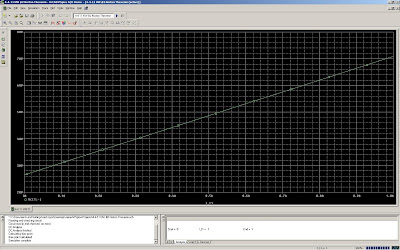We have a sensor whose output is between 0 and +1V, and a signal conditioning circuit whose output must range between 0 and -10V. The signal conditioning circuit cannot draw more than 1mA of current.
 |
| A model of the problem |
This means that we need an inverting operational amplifier with a gain of -10 to make the conversion between the sensor's output and the conditioning circuit's output. The current limitation requires a specific value for resistor Ri.
We calculated this Ri using Ohm's Law:
R=V/I ; Ri = (1V)/(1mA) ; Ri = 1kΩ
Next, we calculated the value of the feedback resistor, Rf, corresponding to the desired gain. For an inverting op-amp:
Vo = -(Rf/Ri) Vi
Using this, we calculated an Rf of 10kΩ.
We needed a way to make a voltage source that varies between 0 and 1V, the voltage range for our sensor. We only have a 6V power supply, but can limit the input voltage to our op-amp by making Rx and Ry much smaller than Ri (this is a voltage divider).
To find Rx, we looked at the leg of the circuit to the left of the op-amp. Setting Ry to zero, we calculated the resistance that would produce a potential difference of 6V while operating at half power (1/8W).
Rx=289Ω (closest available value: 360Ω)
After calculating Rx, we used KVL to find the Ry that would produce the 1V potential difference we're looking for.
Ry=71.8Ω (closest available value: 68Ω)
Finally, we calculated the Thevenin resistance and voltage looking back from the op-amp at the left side of the circuit.
Rth=57.2Ω; Vth=0.955V
Since Rth was about 20 times smaller than Ri, we didn't have to worry about a loading effect on the input circuit.
Next, we built the circuit. We used a decade resistance box for Ry, tweaking it to achieve op-amp input voltages ranging from 0 to 1V. A multimeter was used to measure the corresponding voltage across Ri (the input voltage) and the output voltage.
 |
| Circuit on the breadboard |
 |
| Adjusting the resistances. The reading on one multimeter is -10 times the other |
These were our measurements. Taking the ratio of Vout to Vri, our gain was -10. Using Ohm's Law, we could also calculate the corresponding current through Ri.


The circuit we built matches our design goals; we have a gain of -10, and the current drawn is no more than 1mA when the sensor is at its max value, 1V.











